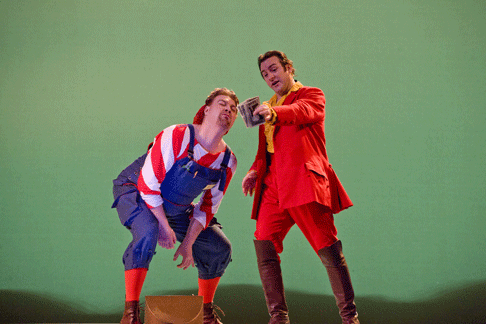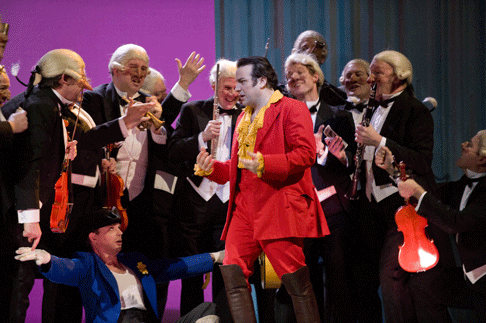Eighteen months later, under the revival
director, Justin Way, the singing is still of a consistently high quality, at
times reaching giddy heights, the costumes are just as gaudily dazzling, and
the setting zany, even giddily anarchic. But, like a magnum of vintage
champagne, its glossy labels promising much but the bottle left uncorked just a
bit too long, this first night performance was distinctly lacking in fizz, the
whole experience dramatically rather flat. When one of the best of all buffa
operas struggles to raise a laugh in its opening hour, you know that something
is not quite right.
There were certainly no complaints about the assembled cast of principals.
American tenor, John Osborn, was musically and dramatically at ease in the role
of Count Almaviva, delivering his opening aria, ‘Ecco ridente’,
nonchalantly balanced in the twilit branches beneath the window of his
beloved’s boudoir. His voice is quite light, and lacks a truly resonant
gleam, but Osborn’s tone is sweet and relaxed, his phrases musically
shaped and his projection even. His gentle lyricism deftly conveyed the
Count’s heartfelt ardour and the anguish of unrequited love; and he
displayed a similarly tender tenore di grazia in his Act 2 ‘Cessa di piu
resistere’. As the evening progressed Osborn settled comfortably into the
comic capers, enjoying the obsequious fawning of music-maestro, Alonso, and
making a convincing and likeable drunken rabble-rouser.
As the self-important factotum, Transylvanian baritone, Levente Moln·r,
exhibited a powerful vocal instrument and bracing stage presence in the role of
Figaro. Emerging from among the ranks of a surprised stall’s audience,
springing athletically onto the stage, he brought an extrovert swagger to the
role of barber and man-about-town. The energy of his entry was sustained
throughout, but I thought there was a bit too much bluster and bluff, and a
tendency to shout, particularly at the start. However, he certainly had the
measure of the tongue-twisting text in ‘Largo al factotum’.
Bruno PraticÚ, as Doctor Bartolo, delivered his patter in similarly
impressive and slick style in his Act 1 aria, ‘A un dottor delta mia
sorte’, and demonstrated a sure sense of comic timing. But, he was
‘out-done’ in the comedy stakes by the extraordinary performance of
Russian bass, Ildar Abdrazakov, whose powerful boom was almost over-shadowed by
his astonishing physical exploits, which suggested that this Basilio was not
only warped by malice and envy but truly demented!
Among this strong cast, the star of the show was, however, Polish soprano,
Aleksandra Kurzak. Only the previous day, Kurzak had signed an exclusive
recording contract with Decca, and the studio must be delighted and excited to
have ‘hooked’ a singer who is certainly a luminary in the making.
Kurzak combines technical assurance with an innate sense of dramatic pacing.
The pyrotechnics scarcely caused her to bat an eyelid: she made it sound
entirely natural to leap between registers and ornament extravagantly —
seldom can coloratura have seemed so ‘normal’ a means of
communication. Her effortless delivery, swooning sweetness turning to steely
feistiness in a flash, was utterly bewitching. And she knows how to play the
audience, her petulant dart-throwing in the middle of a sparkling, nimble
‘Una voce poco fa’, prompted the first real laugh, as
Rosina’s ‘goodness’ — ‘I’m obedient,
gentle, and loving’ — was ironically belied by a sudden flash of
adolescent rage.
 Levente Moln·r as Figaro and John Osborn as Count Almaviva
Levente Moln·r as Figaro and John Osborn as Count Almaviva
The designs are inventive and Christian Fenouillat’s minimalist sets
eye-catching: a crescent moon against a purple sky gleamingly illuminates a
silhouetted tree beneath Rosina’s balcony; stripy pastel clashes and
playful postmodern dots are eye-watering, and emphasise the surreal air of
anarchy. This visual playfulness is aptly complemented by the costumes of
Agostino Cavalca.
Rory Macdonald conducted the ROH orchestra in a precise but unexhilarating
reading of the score, accurate and crisply articulated but lacking frisson or a
sense of risk. The greatest sense of danger came in the Act 1 finale, when the
wildly tilting stage threatened to tip and toss the chorus of plastic-gowned
gendarmes — who struggled gamely to stay upright but gave little
impression of knowing what they would do if they did regain the perpendicular
— into a muddled mound. There was a sense of impending doom as stage and
pit also went adrift. Plenty of chaos, but not much comedy.
 Daniel Grice as Fiorello, John Osborn as Count Almaviva and The Royal Opera Chorus
Daniel Grice as Fiorello, John Osborn as Count Almaviva and The Royal Opera Chorus
During the first revival, American soprano, Joyce DiDonato, did indeed take
a tumble, breaking her leg in the process, and was forced to deliver the
remainder of the run wheel-chair bound. Perhaps it was the added sense of
unpredictably that this lent to the proceedings that kept me on the edge of my
seat last time around. The dress rehearsal for this revival did in fact suffer
its own near-disaster, when the stage set and machinery refused to co-operate
and the cast had to perform in front of the safety curtain, the chorus singing
from the stalls. It seems that this revival needs a touch of the unexpected to
add a little spontaneity and surprise.
Claire Seymour
Click here for Claire’s review of the first revival.
image=http://www.operatoday.com/BARBIERE-10014_0313-KURZAK-.gif
image_description=Aleksandra Kurzak as Rosina [Photo by Mike Hoban courtesy of The Royal Opera House]
product=yes
product_title=Gioachino Rossini: Il barbiere di Siviglia
product_by=Rosina: Aleksandra Kurzak; Count Almaviva: John Osborn; Figaro: Levente Moln·r; Doctor Bartolo: Bruno PraticÚ; Don Basilio: Ildar Abdrazakov; Berta: Jennifer Rhys-Davies; Fiorello: Daniel Grice. Directors: Moshe Leiser, Patrice Caurier. Conductor: Rory Macdonald. Set Designer: Christian Fenouillat. Costume designs: Agostino Cavalca. Lighting: Christophe Forey. Royal Opera House, Covent Garden, Tuesday 18th January 2011.
product_id=Above: Aleksandra Kurzak as Rosina
All photos by Mike Hoban courtesy of The Royal Opera House